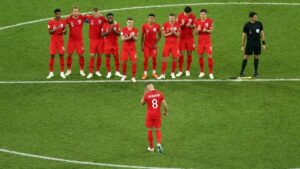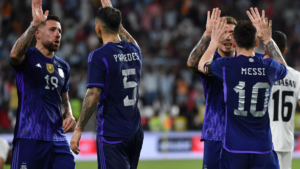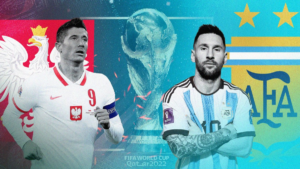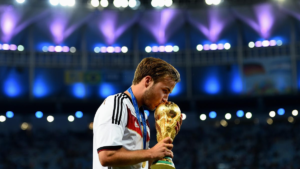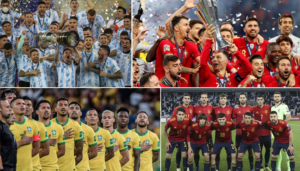This edition of the World cup has provided tons of uncanny events and unexpected results right from the Group stages. Now with only 4 teams left, the World cup has entered the most crucial stage. Before the Semi-finals, Third place play-off and Finale takes place, we must analyse certain factors that are keeping elite footballers away from scoring a penalty.
On Sunday, Harry Kane became the latest English player to miss the target in a 1v1 situation against Hugo Lloris as France outclassed England by 2-1 to enter the Semi-finals. While Kane is known for his impeccable finishing skills and hold up play, he is capable of scoring goals in a lot of ways. However, Kane could not handle the pressure from 12 yards as he fired the ball over the bar.
The English captain also scored one penalty before missing another in the space of 15-20 minutes. By doing so, he joined an infamous list of players at this world cup (Lionel Messi, Robert Lewandowski, Jordan Ayew, Sergio Busquests, Rodrygo and Virgil Van Dijk) – all missing their penalties either on regulation time or on penalty shootouts.
All the credits must go to the goalkeepers who denied the best players from scoring a spot kick. It looks extremely easy on they eye, but trust me it is not. The ratio of penalties saved in this edition (till the last 16) reached its peak since the inception of this rule in 1982.
The average ratio of saved penalties during World cups is 18.3%. This number is of those spot kicks that were on target and in the English Premier League it is close to 17.3%. However, in this edition at Qatar, that figure rose up to 37.9% and it clearly means that even the player with an outstanding technique can struggle to put the ball between the 24 feet wide and 8 feet high goal post.
Thus, here are the 5 reasons why high quality players are struggling to score in penalties.
1. Long walk towards the penalty spot – The walk before taking a penalty can decide a number of things altogether. Firstly, the body language of a player while walking towards the penalty spot can partially determine what the outcome is going to be. For an instance : Lionel Messi’s walk up to the spot against Netherlands seemed very smooth and confident. He was able to convert the penalty without much difficulty and his body language looked very good. On the other hand, Brazil’s Rodrygo who went to take their first spot kick against Croatia at the quarter-finals, looked very uneasy and under immense pressure. As a result, Rodrygo’s effort was saved by opposing goalkeeper Dominik Livakovic. During the 2002 FIFA World Cup, hosts South Korea were preparing to take on Spain in the quarter-final. Korea’s head coach Guus Hiddink made sure that his players walked from one penalty spot to another inside an empty stadium as a part of mental “pre” preparation. It was his way of preparing the players for a short but intense walk from the middle of the pitch to the penalty spot. Hiddink’s preparation paid off as South Korea defeated Spain on penalties and this shows how much of an impact the walk towards the penalty spot can have. England manager Gareth Southgate also shared his thoughts on the walk – “n what is a team environment, you are suddenly the centre of attention with 90,000 people just looking at the walk from the centre circle to the penalty spot. It’s easy then for the brain to take into it things you can’t control just because you haven’t been through that process before… by the time I got to the ball, to get it on the target would be an achievement in itself because the psychological then affects physical movements.”
2. Saving the best player for the last kick doesn’t always work – As much as the walk towards the penalty spot escalates the tension, the waiting time before the referee blows the whistle to kick the ball can also add more tension and uncertainty. The waiting time before the first kick can get a bit lengthy as the Ref’s mandatory talks to both of the Goalie’s is regarded necessary to help them with the rules. So, should teams save their best kicker for the last kick? Not always. Mostly we have seen teams choose their penalty kick line up in reverse to their abilities – the fifth best goes first, the fourth best goes second and so on. It works at times but not for everyone. We saw this in 2 penalty shootouts in this edition. Lionel Messi was sent to take the first penalty for Argentina against Netherlands where Messi was able to score and it calmed the nerves of the players to some extent. The South Americans won that match. Meanwhile, another South American side – Brazil sent World cup debutant Rodrygo for their first penalty and saved Neymar for the last one. However, the match got over even before Neymar’s turn came. Therefore, the first penalty is always crucial as it sets the tone for the next 4 kicks. This year at Qatar, teams that missed their first penalty eventually lost the game and these nations are – Japan, Netherlands, Brazil and Spain.
3. Placement of the penalty – According to statistics, penalties aiming at the upper corners are saved the least because goalkeepers struggle to cover such a large area. When Gareth Southgate missed his kick in the Euro 96 shootout, 9 of the 11 penalties were hit in the top corners. Southgate’s shot was saved because he went low. Penalties taken low along the surface also have a high success rate, but only when they are directed at the side netting and struck with venom, as Cristiano Ronaldo did in his heyday. However, as penalties in this World Cup have demonstrated, precision is critical if the shot is taken low to the ground. It will be preserved if it is little weak, as Japan and Spain have been.
4. Improvement of Goalkeeper’s training, analytics and VAR – Due to the technological invention and advancement, training facilities have certainly improved for not just the goalkeepers but also for the players. During the World cup qualifying inter-continental play-offs, Australian Goalkeeper Andrew Redmayne became the hero as he helped the Socceroos beat Peru in sudden death. Redmayne did more than just making saves, he kicked the water bottle of Peruvian goalkeeper Pedro Gallese away from the posts and rattled his opponents. That particular water bottle had notes of Australian penalty takers pasted over it. Before every kick, Gallese would glance into the instructions and dive accordingly. However, after Redmayne threw the bottle away, Gallese had to rely on complete guesswork. Thus, it is very important for Goalies to remember the notes and instructions. Another factor that helps Goalkeepers is VAR. If we go by the rules, a penalty will be retaken if the goalkeeper moves off his line before the shot.
Also Read – FIFA World Cup 2022 : 3 reasons why Croatia are a better side than 2018 FIFA World Cup
2022 FIFA World cup at Qatar is just 4 matches away from concluding with 2 Semi-finals, Third place play-off and the Grand Finale yet to be played out.



